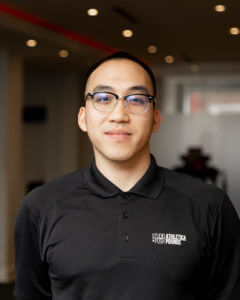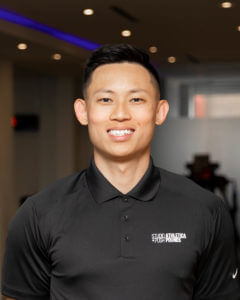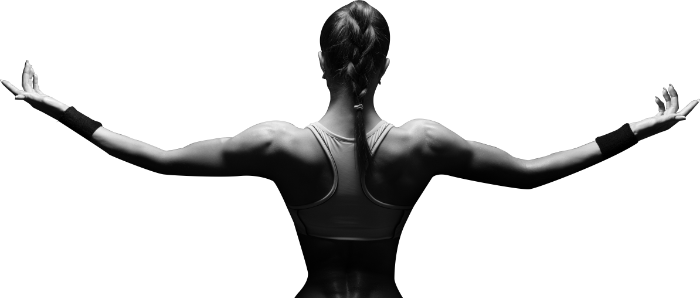Graston Technique
The Graston Technique is a form of manual therapy commonly used in chiropractic care that involves massaging and gently scraping the skin. It is a patented therapy process that uses stainless-steel tools for soft tissue mobilization and is one of the leading manual therapy approaches being used today. The Graston Technique is mainly used by chiropractors but is also used by physiotherapists, osteopathic physicians, occupational therapists and even some registered massage therapists in Canada.
Push Pounds Sports Medicine has certified Graston Technique therapists who utilize the procedure to help manage pain and restore mobility and overall function.
Graston Technique Specialists

Dr. Alan Bui, DC, BSc
Spine & Extremity Chiropractor
Clinic Director
Dr. Alan Bui is a board-certified chiropractor who holds a doctorate from the New York Chiropractic College. He utilizes a customized approach that is unique to each individual’s case and goals. With a particular interest in extremity-based care, Dr. Bui combines integrative manual therapy and full-body movement exercises to manage different types of musculoskeletal conditions.
Dr. Bui’s approach is multi-modal and is tailored to the unique needs of the individual. His specializations include cryotherapy and compression therapy, assisted soft tissue techniques, custom ACL/PCL bracing, shockwave and manual adjustments. Dr. Bui also creates custom-made orthotics using 3D cutting edge laser technology. Outside of the clinic, Dr. Bui lives a healthy and active lifestyle. He enjoys working out, playing sports, reading and listening to podcasts.

Joshua Irwanto, MSc, PT, BA (Hons) Kin, CSCS
Registered Physiotherapist
Certified Strength & Conditioning Specialist
Functional Range Conditioning® Mobility Specialist
Josh is an avid believer in evidence-based treatment methods specializing in modalities, manual therapy, therapeutic taping, and corrective and functional exercises. His treatment approach is heavily client-focused, ensuring that each treatment plan is tailored towards the client’s goals. Josh completed his Masters of Physiotherapy in Aberdeen, Scotland, shortly after earning his Specialized Honours Bachelor’s Degree in Kinesiology & Health Sciences at York University.
Josh started being interested in functional training and sports performance injuries after experiencing a severe sports-related lower back injury in 2014. During his time in Scotland, Josh had valuable experience in treating patients in diverse settings, including orthopedics, neurology, cardio-respiratory therapy, pre/post-operative rehabilitation and in community visits. Outside of work, Josh is a member of the Robert Gordon University varsity basketball team and continues to live an active lifestyle through basketball, outdoor hiking, and fitness training.
What Instruments Does the Graston Technique Use?
Graston instruments are specially designed to systematically follow the kinetic chain to identify the exact area that causes discomfort in order to treat the symptoms. Through these instruments, expert Graston therapists can carefully and precisely detect adhesions and restrictions in the muscle. Such devices are available only to certified Graston Technique providers.
The complete set of GT instruments includes six unique stainless-steel tools for delivering different treatment techniques all over the body, aptly called GT1, GT2, GT3, GT4, GT5, and GT6.
- GT1: quadriceps, hamstrings, glutes, back extensors, upper traps
- GT2: biceps, triceps, wrist flexors and extensors, elbow, patella, heel
- GT3: precision lesion localization
- GT4: everywhere
- GT5: cervical spine, deltoid, gastrocnemius, adductors, intercostals
- GT6: digital, interossei, Achilles
Most Common Conditions the Graston Technique Treats
Graston Technique, when combined with other tried-and-tested treatments, can help accelerate healing and recovery. Some of the conditions where this technique has been proven effective are:
- Achilles Tendinitis: Graston Technique helps address tension in the muscles that lead to pain in the Achilles heel.
- Ankle Sprain: Following a sprain from a sports injury or maybe simply a misstep while walking, you should ice the area immediately, support it with a splint or bandage and then take X-rays to confirm the extent of the damage. As scar tissue can take just hours to form from a sprain, the Graston Technique can help hasten healing and break scar tissue down (thereby reducing the risk of re-occurrence).
- Plantar Fasciitis: Foot dysfunctions can lead to increased pressure points that result in pain, including plantar fasciitis. Graston Technique can help break down adhesions and scar tissue in the foot and calf.
- Low Back Pain: Low back pain is typically the result of strains, sprains, sciatica, herniated discs, disc degeneration or traumatic injury. Adding the Graston Technique to a therapy program can help reduce pain and inflammation, as well as improve your mobility and range of motion.
- Tennis Elbow: Also referred to as a golfer’s elbow, this condition comes from the overuse of tendons around the elbow that eventually lead to pain. Graston Technique can help break down the adhesions that have formed in the fascia, tendons and muscles.
- Hip Pain: The joint on the hip bears the most weight of all of the joints in the body, and can eventually give way to overuse, thereby causing plenty of pain. Graston Technique has been observed to be one of the most effective soft tissue treatments by breaking down fibrotic tissue and adhesions on the hip area.
- Hamstring Strain: Hamstring strains are common among cyclists, runners and those who do aerobic activities. Graston Technique is one of the most effective treatments in addressing adhesions that cause pain.
- Rotator Cuff Tendinitis: This condition is characterized by a dull pain on the shoulder and upper arm that extends to the elbow. Graston Technique helps relieve symptoms and eventually promote healing by breaking down the scar tissue and adhesions at the site of pain.
- Carpal Tunnel Syndrome (CTS) and Wrist Tendonitis: CTS involves injury on the veins, arteries, and nerves in the area between the hand and the wrist. It is typically caused by working too long on a computer, using heavy hand-held tools, or sports. Graston Technique can break down the scar tissue on the area and provide relief from CTS and wrist injury-related symptoms.
Need more information about how Graston Technique can help relieve muscle and joint pain? We can help! Get in touch with us at 416-722-3393.

